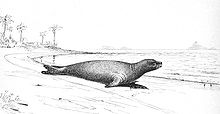- Caribbean Monk Seal
-
Caribbean monk seal 
Conservation status Scientific classification Kingdom: Animalia Phylum: Chordata Class: Mammalia Order: Carnivora Suborder: Pinnipedia Family: Phocidae Genus: Monachus Species: M. tropicalis Binomial name Monachus tropicalis
(Gray, 1850)The Caribbean monk seal or West Indian monk seal (Monachus tropicalis) is an extinct species of seal. It is the only seal ever known to be native to the Caribbean Sea and the Gulf of Mexico. The last verified recorded sighting occurred in 1952 at Serranilla Bank.[1] On June 6, 2008, after five years of futile efforts to find or confirm sightings of any Caribbean monk seals, the U.S. government announced the species is officially extinct, and the only seal to vanish due to human causes.[2]
A collection of Caribbean monk seal bones can be found at the Tropical Crane Point Hammock Museum in Key Vaca.
Contents
Physical appearance
The Caribbean monk seal was a relatively large seal (1.8-2.7 m), with rolls of fat around its neck and brown pelage that faded to a yellow-white color on the stomach. The soles and palms were naked, with the nails on the anterior digits well developed. The males reached a length of about 3.25 meters and weighed up to 200 kilograms. Displaying sexual dimorphism, the females of this species were generally smaller than males.[3]
Behavior and ecology
These pinnipeds lived in the marine environment, spending much of their time in the water and occupying rocky and sandy coastlines for shelter and breeding. Their diet included lobsters, octopuses, and reef fish.
Like other true seals, the Caribbean monk seal was sluggish on land. Its lack of fear for man and an unaggressive and curious nature also contributed to its demise.
Reproduction and longevity
Very little is known about the reproduction behavior and longevity of this animal. Live pups were likely born in early December because several females killed in the Yucatan during this time of the year had well-developed fetuses. It is believed this animal's average lifespan was approximately twenty years.
History
During his 1494 voyage, Christopher Columbus described the Caribbean monk seal as a "sea-wolf". During that voyage, eight seals were killed for their meat. The region was soon colonized, and whatever habitat this species had was lost. People also began exploiting it commercially for its oil, and less frequently, for its meat. It became extinct in the 1950s from lack of food.[citation needed]
Sightings
In the United States, the last recorded sighting of this marine mammal occurred in 1932 off the Texas coast. The very last reliable records of this species are of a small colony at Serranilla Bank between Honduras and Jamaica in 1952.[1]
Unconfirmed sightings of Caribbean monk seals by local fishermen and divers are relatively common in Haiti and Jamaica, but two recent scientific expeditions failed to find any sign of this animal. It is possible the mammal still exists, but some biologists strongly believe the sightings are of wandering hooded seals, which have been positively identified on archipelagos such as Puerto Rico and the Virgin Islands. On April 22, 2009, The History Channel aired an episode of Monster Quest, which hypothesized an unidentified sea creature videotaped in the Intracoastal Waterway of Florida's southeastern coast could possibly be the extinct Caribbean monk seal. No conclusive evidence has yet emerged in support of this contention, however, and opposing hypotheses asserted the creature was simply a misidentified, yet common to the area, West Indian manatee.
See also
References
- ^ a b c Kovacs, K. (2008). Monachus tropicalis. In: IUCN 2008. IUCN Red List of Threatened Species. Downloaded on 6 January 2009.
- ^ "It's official: Caribbean monk seal is extinct", MSNBC.com 6 June, 2008
- ^ Peter Saundry. 2010. Caribbean monk seal. Encyclopedia of Earth. eds. C.Micahel Hogan and Cutler Cleveland. National council for Science and the Environment, Washington DC
- ADW: Monachus tropicalis
- Feds: Caribbean Monk Seal Officially Extinct Fox News
- National Marine Fisheries Service Caribbean monk seal webpage
External links
- Fact files: Caribbean Monk Seal, Monachus tropicalis
- The Extinction Website - Species Info - Monachus tropicalis
Extinct species of superfamily Pinnipedia Kingdom: Animalia · Phylum: Chordata · Class: Mammalia · Order: Carnivora · Suborder: Caniformia Phocidae Monachopsis · Pristiphoca · Properiptychus · Messiphoca · Mesotaria · Callophoca · Pliophoca · Pontophoca · Caribbean Monk Seal (Monachus tropicalis)PacificaPiscophocaCapensisHomiphocaKawas benegasorumLenisLeptophocaPreapusaPreapusaPhocinaeCryptophocaPhocanellaPhocanellaPlatyphocaPlatyphocaGryphocaGryphocaOtariidae Odobenidae Imagotaria downsiCategory Categories:- IUCN Red List extinct species
- Extinct carnivorans
- Extinct mammals
- Species made extinct by human activities
- Natural history of the Caribbean
- Extinct animals of the Caribbean
- Mammal extinctions since 1500
- True seals
Wikimedia Foundation. 2010.


